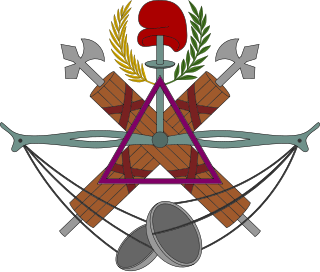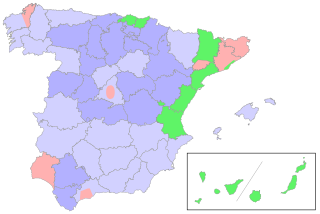
The Spanish Socialist Workers' Party is a social-democratic political party in Spain. The PSOE has been in government longer than any other political party in modern democratic Spain: from 1982 to 1996 under Felipe González, 2004 to 2011 under José Luis Rodríguez Zapatero, and since 2018 under Pedro Sánchez.

Alejandro Lerroux García was a Spanish politician who was the leader of the Radical Republican Party. He served as Prime Minister three times from 1933 to 1935 and held several cabinet posts as well. A highly charismatic politician, he was distinguished by his demagogical and populist political style.
Since the beginning of liberalism in Portugal in the 19th century, several parties have, by gaining representation in parliament, continued the liberal ideology in contemporary Portuguese politics. But after the initial fervor of the Liberal Revolution of 1820 and the outcome of the Liberal Wars (1828–1834) during the 19th century, liberalism was relegated to a secondary role in Portuguese politics and government and even outlawed for periods of time. The first fully-fledged liberal party founded as such to have a seat in the Portuguese Parliament since the end of the First Portuguese Republic (1910–1926), was the Liberal Initiative, in 2019.
This article gives an overview of liberalism and radicalism in Spain. It is limited to liberal and radical parties with substantial support, mainly proved by having been represented in parliament. The sign ⇒ denotes another party in that scheme. For inclusion in this scheme it is not necessary that parties label themselves as a liberal or radical party.

In the history of contemporary Spain, the death of caudillo Francisco Franco on 20 November 1975 marked the beginning of the Spanish transition to democracy, the establishment of the parliamentary monarchy and the subsequent accession of King Juan Carlos I to the throne. In 1978, the current Spanish Constitution of 1978 was signed and the status of Spain's autonomous entities (autonomías) was defined.
Republican Action was a Spanish left-liberal republican party between 1930 and 1934.

The Radical Republican Party, sometimes shortened to the Radical Party, was a Spanish Radical party in existence between 1908 and 1936. Beginning as a splinter from earlier Radical parties, it initially played a minor role in Spanish parliamentary life, before it came to prominence as one of the leading political forces of the Spanish Republic.

Legislative elections were held in Spain on 16 February 1936. At stake were all 473 seats in the unicameral Cortes Generales. The winners of the 1936 elections were the Popular Front, a left-wing coalition of the Spanish Socialist Workers' Party (PSOE), Republican Left (Spain) (IR), Esquerra Republicana de Catalunya (ERC), Republican Union (UR), Communist Party of Spain (PCE), Acció Catalana (AC), and other parties. Their coalition commanded a narrow lead over the divided opposition in terms of the popular vote, but a significant lead over the main opposition party, Spanish Confederation of the Autonomous Right (CEDA), in terms of seats. The election had been prompted by a collapse of a government led by Alejandro Lerroux, and his Radical Republican Party. Manuel Azaña would replace Manuel Portela Valladares, caretaker, as prime minister.

Elections to Spain's legislature, the Cortes Generales, were held on 19 November 1933 for all 473 seats in the unicameral Cortes of the Second Spanish Republic. Since the previous elections of 1931, a new constitution had been ratified, and the franchise extended to more than six million women. The governing Republican-Socialist coalition had fallen apart, with the Radical Republican Party beginning to support a newly united political right.

The 1931 Spanish general election for the Constituent Cortes was the first such election held in the Second Republic. It took place in several rounds.
The background of the Spanish Civil War dates back to the end of the 19th century, when the owners of large estates, called latifundios, held most of the power in a land-based oligarchy. The landowners' power was unsuccessfully challenged by the industrial and merchant sectors. In 1868 popular uprisings led to the overthrow of Queen Isabella II of the House of Bourbon. In 1873 Isabella's replacement, King Amadeo I of the House of Savoy, abdicated due to increasing political pressure, and the short-lived First Spanish Republic was proclaimed. After the restoration of the Bourbons in December 1874, Carlists and anarchists emerged in opposition to the monarchy. Alejandro Lerroux helped bring republicanism to the fore in Catalonia, where poverty was particularly acute. Growing resentment of conscription and of the military culminated in the Tragic Week in Barcelona in 1909. After the First World War, the working class, the industrial class, and the military united in hopes of removing the corrupt central government, but were unsuccessful. Fears of communism grew. A military coup brought Miguel Primo de Rivera to power in 1923, and he ran Spain as a military dictatorship. Support for his regime gradually faded, and he resigned in January 1930. There was little support for the monarchy in the major cities, and King Alfonso XIII abdicated; the Second Spanish Republic was formed, whose power would remain until the culmination of the Spanish Civil War. Monarchists would continue to oppose the Republic.

Álvaro de Albornoz y Liminiana was a Spanish lawyer, writer, and one of the founders of the Second Republic of Spain.

Republicanism in Spain is a political position and movement that believes Spain should be a republic.

Women in the Spanish Socialist Workers' Party were few in number, mainly as a result of the Spanish Socialist Workers' Party (PSOE)'s resistance to women's rights. The party had opposed the women's rights movement, seeing it as a bourgeois endeavor that interfered with their ability to work for labor rights. Despite warnings from prominent women about the problems related to this position, they re-affirmed it several times in the period prior to the Dictatorship of Primo de Rivera.
Vicente Fatrás Neira was a Spanish politician. In his younger years he was also one of Spain's first racing cyclists.

Rafael Salazar Alonso was a Spanish lawyer, newspaper proprietor and politician who engaged in left-wing and right-wing politics. He was the mayor of Madrid and a government minister. He was executed by the Republican authorities two months after the Spanish Civil War started.
The Republican Alliance was a Spanish political platform that brought together several republican parties and groups during the dictatorship of Primo de Rivera. The alliance was formed on 11 February 1926, and consisted of four political groups ranging in various types of republicanism:

Marcelino Domingo Sanjuán was a Spanish teacher, journalist, and politician who served as a minister several times during the government of the Second Spanish Republic.
The IndependentRadical Socialist Republican Party was a minor Spanish radical political party, created in 1929 after the split of the left-wing of the Radical Socialist Republican Party. Its main leaders were Marcelino Domingo, Álvaro de Albornoz and Ángel Galarza.










